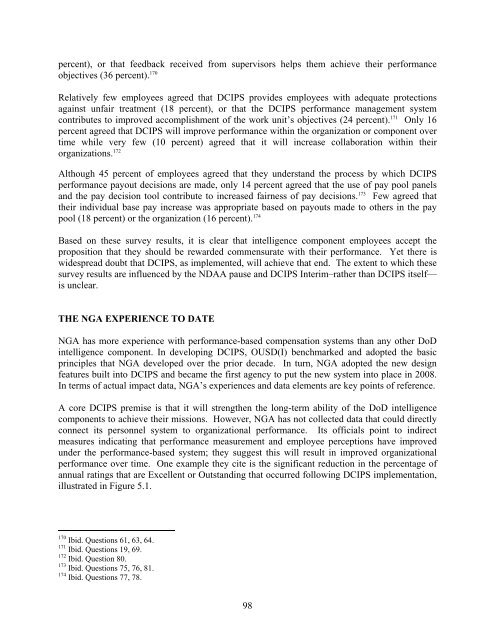Report - Government Executive
Report - Government Executive
Report - Government Executive
Create successful ePaper yourself
Turn your PDF publications into a flip-book with our unique Google optimized e-Paper software.
percent), or that feedback received from supervisors helps them achieve their performance<br />
objectives (36 percent). 170<br />
Relatively few employees agreed that DCIPS provides employees with adequate protections<br />
against unfair treatment (18 percent), or that the DCIPS performance management system<br />
contributes to improved accomplishment of the work unit’s objectives (24 percent). 171 Only 16<br />
percent agreed that DCIPS will improve performance within the organization or component over<br />
time while very few (10 percent) agreed that it will increase collaboration within their<br />
organizations. 172<br />
Although 45 percent of employees agreed that they understand the process by which DCIPS<br />
performance payout decisions are made, only 14 percent agreed that the use of pay pool panels<br />
and the pay decision tool contribute to increased fairness of pay decisions. 173 Few agreed that<br />
their individual base pay increase was appropriate based on payouts made to others in the pay<br />
pool (18 percent) or the organization (16 percent). 174<br />
Based on these survey results, it is clear that intelligence component employees accept the<br />
proposition that they should be rewarded commensurate with their performance. Yet there is<br />
widespread doubt that DCIPS, as implemented, will achieve that end. The extent to which these<br />
survey results are influenced by the NDAA pause and DCIPS Interim–rather than DCIPS itself—<br />
is unclear.<br />
THE NGA EXPERIENCE TO DATE<br />
NGA has more experience with performance-based compensation systems than any other DoD<br />
intelligence component. In developing DCIPS, OUSD(I) benchmarked and adopted the basic<br />
principles that NGA developed over the prior decade. In turn, NGA adopted the new design<br />
features built into DCIPS and became the first agency to put the new system into place in 2008.<br />
In terms of actual impact data, NGA’s experiences and data elements are key points of reference.<br />
A core DCIPS premise is that it will strengthen the long-term ability of the DoD intelligence<br />
components to achieve their missions. However, NGA has not collected data that could directly<br />
connect its personnel system to organizational performance. Its officials point to indirect<br />
measures indicating that performance measurement and employee perceptions have improved<br />
under the performance-based system; they suggest this will result in improved organizational<br />
performance over time. One example they cite is the significant reduction in the percentage of<br />
annual ratings that are Excellent or Outstanding that occurred following DCIPS implementation,<br />
illustrated in Figure 5.1.<br />
170 Ibid. Questions 61, 63, 64.<br />
171 Ibid. Questions 19, 69.<br />
172 Ibid. Question 80.<br />
173 Ibid. Questions 75, 76, 81.<br />
174 Ibid. Questions 77, 78.<br />
98













